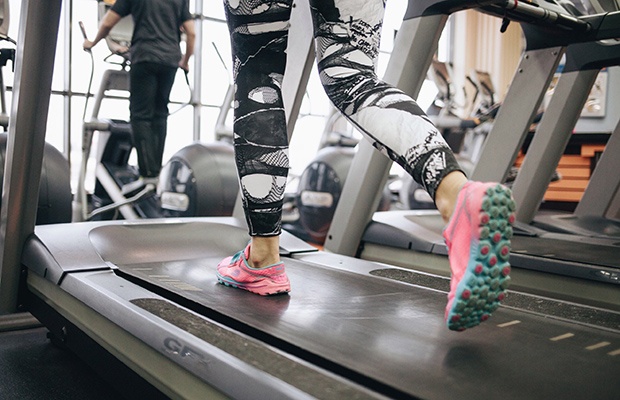Plantar fasciitis can happen in a snap. You get out of bed one morning, and the minute you set one heel down on the floor, it starts throbbing. You did a tough workout the day before and had some heel pain but nothing serious. Weird, right?
Plantar fasciitis is actually the most common cause of heel pain, and it strikes a whopping two million individuals every year, according to the American Academy of Orthopedic Surgeons (AAOS). Although it’s an injury that can affect anybody, certain conditions make it more likely. “The heavier you are, the more you jump, the worse your shoes, the harder the surface you’re on, the more you increase your risk,” says Alan Shih, D.P.M., director of podiatry at Head to Toe Healthcare in Tucson, AZ. Other risk factors include having a high arch, tight calf muscles (you can tell if you have trouble flexing your foot toward your shin), repetitive activity and either new or increased activity, per the AAOS.
Plantar Fasciitis: Runners’ Workout Woe
So what is plantar fasciitis? “Plantar fasciitis is a repetitive-use stress injury, which is why it’s so common in runners who do little else but run,” says Briant Burke, MD, creator of HeelAid.
The plantar fascia is a ligament on the bottom of your foot that connects your heel to the front of your foot. “Think of when you cut a piece of steak, and you encounter the tough white stuff,” Shih says. That’s your fascia.
The fascia can typically handle huge amounts of stress — every heel strike you make as you walk generates about 1,000 pounds of force per square inch. But too much pressure or strain can damage it and cause inflammation, says Burke. One of the most common symptoms of plantar fasciitis is heel pain first thing in the morning, although not everybody experiences this. Heel pain might also occur after being on your feet all day or during certain activities, Shih says, so it’s best to see a doctor to get a proper diagnosis.
If you’re highly active, the best thing you can do to prevent plantar fasciitis is to mix up your workouts so don’t put too much stress on your feet. For example, run four days a week instead of five and supplement your training with foot-friendly activities like cycling, yoga and rowing. You should also vary the surfaces on which you train. Concrete is hard on the feet, so switch to a track or grass every now and then. And, going barefoot (especially on hard surfaces) is worst for your feet.
How to Treat Plantar Fasciitis at Home
Once you start feeling heel pain, don’t ignore it. “If you want to recover faster, intervene early or the pain will get worse and you’ll be looking at a longer recovery,” Burke says. Depending on the severity, plantar fasciitis can take weeks, even months, to heal.
First, modify your activities so that you decrease the pounding on your plantar fascia. Whether you’ll have to give up your workouts depends on the severity of your pain. “If it’s mild, you might be able to work around it,” Shih says. Severe pain, on the other hand, calls for choosing a gentler form of exercise, where you’re less on your feet.
Shih also recommends icing your heel within the first 48 to 72 hours of feeling pain. Wrap a towel around an ice pack and apply it two to three times a day for no longer than 20 minutes. While you sleep at night, consider wearing a splint to stretch the calf muscles and make stepping out of bed in the morning less painful. “More flexibility generally allows for less stiffness and pain and a quicker return to activity,” Shih says. Anti-inflammatories like ibuprofen and naproxen can also help alleviate the pain. Another relied strategy: massaging your heel by running your thumbs up and down the plantar fascia.
Don’t forget to evaluate the condition of your shoes, too — adequate support is key. Your podiatrist can also provide orthotics and inserts for your shoes to help prevent and treat plantar fasciitis. “They provide support and reduce strain on the feet and plantar fascia,” Shih says. Custom orthotics are ideal because they help lock the foot bones in a certain position to makes them more stable. Pro tip: Buy shoes at the end of the day because your feet get bigger as the day progresses, and make sure you measure both feet, Burke says.
3 Stretches to Relieve Plantar Fasciitis Heel Pain
When in doubt, Shih recommends stretching it out. Try Shih’s three stretches several times daily and hold each pose for 30 seconds.
1. Gastroc Stretch
How to: Stand facing a wall with arms extended, palms flat on wall at shoulder height (a). Step your injured heel back until the knee is straight, and the heel is flat and the foot is turned inward slightly (b). Without lifting the heel or bending the knee, press your hips forward until you feel a stretch in the calf of the injured heel (c). Switch sides and repeat.
2. Doorway Stretch
How to: Stand a foot away from a door with your hands on the door for support (a). Step the uninjured leg forward and the injured leg back with the heel flat on the floor. Then, turn the injured foot slightly inward (b). Slowly lean into the door so you feel the stretch in your calf (c). To make the stretch more intense, lean forward more (d). Switch sides and repeat.
3. Stair Stretch
How to: Stand on a step with your heels hanging off the step (a). Keeping your knees straight, slowly let your heels drop until you feel a stretch in the calves (b).









